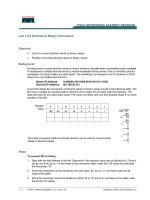Tài liệu DC Power: Is it Time to Switch? pdf
Bạn đang xem bản rút gọn của tài liệu. Xem và tải ngay bản đầy đủ của tài liệu tại đây (839.81 KB, 4 trang )
white paper
DC Power: Is it Time to Switch?
As operators move from the realm of being video-only providers to serving up data
and telephony, they should consider the option of DC powering for multiple services
There was a time when cable was simple. Operators had virtual monopolies, so competition was not an
issue. They delivered a single programming feed, leaving any sorting out to be done at the set-top. And
powering headend or hub equipment was nearly as simple as plugging a toaster into an AC outlet.
A Whole New World
That was then. Today, competition is intense and becoming ferocious. Cable companies are expected to
deliver advanced video services, voice and data, just to stay competitive. And if subscribers aren’t satisfied
with what one provider offers, they can turn to overbuilders, satellite broadcasters or a phone company
for what they want. Not surprisingly, power requirements are changing, along with everything else.
Operators have some complex choices to make. But there’s one area where there is no choice: powering
telephony equipment. Telephony has never used AC. It uses -48 VDC, and chances are, it always will. In
other words, operators planning to offer the telephony services that subscribers demand will have to
power equipment with -48 VDC.
Why Not the Works?
Most electronic equipment is already DC. Even if it plugs into an AC outlet, it uses an internal power
supply to convert AC to the DC it
needs. The change taking place today
is in where that conversion takes
place.
There are good reasons to convert
headends and hubs to DC power, and
in spite of the conversion cost, some
savvy operators are doing just that.
Although many operators continue to
rely mostly on AC, the future clearly
favors DC power in headend and hub
facilities. DC powering for non-
telephony equipment only began
appearing in the mid-1990s. It takes
some getting used to, but because it
fits so well with the direction of
today’s markets, operators should at
least consider the DC power option.
Power Equipment
AC Power
Distribution
Incoming
AC Power
Primary
Power Panel
Rectifiers
Batteries
Primary Power
Distribution (BDFB)
Secondary Power
Distribution
Fuse Panel
DC-Powered
Equipment
DC-Powered
Equipment
Power Distribution Scenarios
2
The Cost of Change
Network operators should know the following
about DC power in multi-service operations:
• It involves a significant initial capital outlay –
more than traditional AC, but still only a small
fraction of the cost of building a headend or hub.
• ADC plant uses somewhat more “real estate”
than an AC system, much of it for the
required battery banks.
• Though it isn’t really complicated to use, there
is a learning curve for a staff that’s used to AC.
• Initial installation of the primary DC system
should probably be left to experts.
• There are still a few kinds of equipment that
do not offer a DC power option.
So why are some of the fastest-growing operators
in the world making the change to DC? The
answer is simple: Reliability.
Reliability Rules
As important as video service can be to subscribers,
it’s not a matter of life and death. Telephony, on
the other hand, is a “lifeline” service, with legal
liabilities to match. Subscribers may not know
about Telcordia’s 99.999 percent telephony-uptime
standard, but they take that level of service – mere
minutes of lost service each year – for granted.
Data, too, is becoming a critical service.
At the same time, as competition grows, attitudes
toward traditional video are changing as well. In
today’s post-deregulation markets, subscribers
increasingly have a choice of video suppliers, and
are as likely to disconnect over poor service as over
price or programming.
Reliable Power for Reliable
Systems
In a world of super-reliable integrated circuits,
power problems remain a leading cause of service
interruption at the headend or hub. The problem
can be as small as a bumped AC plug or blown
fuse, or as large as a neighborhood outage. It can
be as intentional as a rack powered down for
repair or as hidden as a faulty connector. Whatever
or wherever it is, it will probably affect subscribers.
In today’s competitive multi-service market, that
means lost revenue.
It also means expense in tracking down and
correcting the problem. As systems get larger and
more intricate, even small failures can be costly to
locate and repair, especially with experienced
technical staff getting harder to find and more
expensive to keep. In that kind of environment, any
investment that eliminates causes of failure or
speeds repair will pay for itself. DC power is exactly
that kind of investment.
The DC Difference
Incoming AC power from the local power plant is
converted at the headend facility. The AC is
converted to DC through the use of rectifiers. The
rectifiers feed DC power to the primary power
panel, which in turn feeds the BDFB (battery
distribution fuse bay). Rectifiers also keep the
battery banks charged in case of an AC power
failure backing up the feed to the power panel. If
external power fails, the batteries continue to
power the equipment with no “switchover,” like
that of an AC uninterruptible power supply (UPS).
Combined, these DC sources make up redundancy
for feeding the BDFB.
Sizing the battery plant depends on:
• the amount of equipment supported
• the amount of unpowered “float” time
required
• anticipated rate of growth.
The BDFB is typically equipped with circuit breakers
or fuses and serves DC power to multiple racks of
equipment. This secondary power distribution is to a
dedicated fuse panel or equipment located in equipment
relay racks. In addition to providing more protection
than AC – a single blown fuse affects far less
equipment – the fuse panels allow A-B redundancy.
This provides two parallel power paths from the
fuse panel to each individual piece of equipment,
reducing the chance of power interruption. If one
path fails, the other continues to supply power,
allowing the device to continue to operate.
DC Takes Center Stage
As more operators choose the DC route, suppliers
are avidly supporting the move by offering their
equipment in a DC-ready configuration. Equipment
that can be DC-powered now includes:
• Optical transmitters and receivers
• Uncompressed digital transmission equipment
• Video modulators
• Upconverters
• Host digital terminals (HDTs)
• Data-Over-Cable Service Interface Specification
(DOCSIS) equipment
• QAM modulators
• RF amplifiers
• Network monitoring equipment
• Satellite receivers
• and more.
PowerWorx
®
Advantage Series
™
ADC's PowerWorx
®
Advantage Series
™
Platform supports the high power demands
of wireless, optical broadband access and IP-
based equipment. It provides up to 300A of
input power per bus and 125A per high-
current output position, all in a compact unit
that helps reduce space requirements in
crowded central offices.
PowerWorx
®
Select Series
™
ADC's PowerWorx
®
Select Series
™
fuse and
circuit breaker panels power and protect
valuable, revenue-generating network
equipment in broadband multimedia
networks.
DC in Action
There are operators already using DC to power virtually
everything they use. The impact is apparent almost immediately.
• DC power is conditioned power, so equipment tends to run
more reliably and efficiently.
• Systems can be configured for longer standby at the hubs –
up to eight hours.
• Since equipment is direct-wired rather than plugged in,
connections are unlikely to be inadvertently disconnected.
• Each piece of equipment is now individually fused. AC
typically provides only two breakers for a 10-plug strip, so
one tripped breaker takes down a lot of equipment.
• There is A-B power redundancy to each individual piece of
equipment.
• It is easier to monitor the DC power plant.
• Cable management is cleaner.
Riding the Learning Curve
There’s no denying that DC installation is a learning process, and
initially more expensive than AC. The real payoff comes from
ongoing operations – increased reliability and reduction of lost
revenue. Initial installation should probably be left to a qualified
DC vendor, and operators should plan to thoroughly train
technical personnel.
Because the DC plant is negative 48 VDC and has different
grounding requirements than AC, DC circuits appear “backwards”
to AC-trained technicians. Retraining often involves some initial
confusion and some blown fuses, but that’s what training is for.
It’s also an opportunity for technicians to learn, preferably from
outside experts, how DC circuits are run and tied down.
Site designers should also plan for completely separate overhead
runs for DC, fiber, audio/video, and RF cabling. This can simplify
management, speed repair, eliminate problems caused by
unnecessary handling and maintain codes and standards.
Taking the Plunge
Having established that conversion to DC will not be easy, the
question becomes how to make it easier. Here are some simple steps.
• Pay close attention to standards. Power systems for
communications are some of the most rigorously tested and
standardized of all products. By demanding the highest
levels of standards-compliance in products used,
unnecessary problems can be avoided. Approvals should
include: Underwriter’s Laboratories; Network Equipment
Building Standards (NEBS), a standard set by Telcordia
(formerly Bellcore); National Electrical Code, written by the
National Fire Protection Agency; Conformité Européenne is
required of telecommunications equipment sold into the
European Union and global markets.
• If you are a dominant carrier, you may be able to generate
additional revenue by sharing facilities with other providers.
These providers will be co-locating and connecting to your
network. The standards you set will carry over to those you
3
ADC’s
PowerWorx
®
Products
ADC Telecommunications, Inc., P.O. Box 1101, Minneapolis, Minnesota USA 55440-1101
Specifications published here are current as of the date of publication of this document. Because we are continuously improving our products, ADC
reserves the right to change specifications without prior notice. At any time, you may verify product specifications by contacting our headquarters
office in Minneapolis. ADC Telecommunications, Inc. views its patent portfolio as an important corporate asset and vigorously enforces its patents.
Products or features contained herein may be covered by one or more U.S. or foreign patents. An Equal Opportunity Employer
1264211 6/03 Original © 2003 ADC Telecommunications, Inc. All Rights Reserved
Web Site: www.adc.com
From North America, Call Toll Free: 1-800-366-3891 • Outside of North America: +1-952-938-8080 Fax: +1-952-917-3237
For a listing of ADC’s global sales office locations, please refer to our web site.
interface with, and will enable you to protect your network.
• Look for modularity in power components. The ability to mix and match interfaces and fuse types
will help control “sprawl” in your equipment bays.
• Demand the highest level of physical protection for equipment and cables. At the same time, look
for ease of access for maintenance and repair.
• Make a commitment to thorough training. People are the most valuable asset, especially in today’s
labor market. Anything you can do to keep them safe and make them efficient will pay big
dividends.
• Don’t be afraid to hire or retain experts to help with the conversion. When entering unknown
territory, it pays to bring an experienced guide.
The Bottom Line
There’s no need to be afraid of DC powering. It has been around in the telephony world for most of a
century. It works and has shown itself to be reliable and safe. It is supported by a growing number of
equipment vendors and has already been adopted by some very demanding operators. Like any
investment, it will cost you money, but the risks are controllable and the payback is clear. You don’t
necessarily have to be the next to go DC, but when the time comes, it will pay to be ready.









